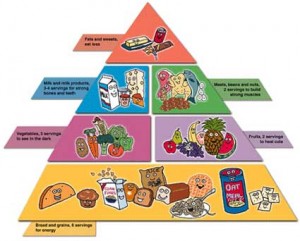Have you noticed the numerous commercials that run during child television programming? It is reported that children are exposed to over 30,000 advertisements for sugary foods and drinks per year. That’s pure brainwashing at its best. Do you also notice that candy and sodas are also strategically placed right by the checkout in grocery stores? Sugar is dominant in our society; however, there is bad and good about it. So how do you know the difference and how much is okay?
Bad vs. Good Sugars
Refined sugar is a simple carbohydrate, which is often found in some cereals, sodas, fruit drinks, candy, and baked goods. Glucose delivered in these simple carbohydrate forms is often referred to as “empty calories” due to their lack of nutritional value. Natural sugars, or complex carbohydrates, found in fruits, some vegetables, and whole grains are healthier for children due to its nutritional value that outweighs the sugar. Approximately 40% of your child’s diet should come from complex carbohydrates, which is easily digestible and contains fiber for satiety.
Health Related Problems in Children
You probably have heard, since your own childhood, “Don’t eat too much candy otherwise you are going to have cavities”. You probably even told that to your own child. This is true, but refined sugars do more harm to your young child than you may be aware of:
- Weakens Immune System – As your child’s immune system is weekend, he or she will be more prone to developing diseases ranging from skin disorders (warts and psoriasis) to cancer. The white blood cells’ ability to fight disease decreases by 40% with a high intake of refined sugars.
- Causes Obesity – The average child consumes about 16% of his or her daily calories from sugar. With 1 gram equal to 4 calories, that is almost an extra 350 – 700 calories a day. Recent studies in American report that 1 in 3 children are considered obese. In addition, the excess sugar that can’t be broken down and used is stored as fat in the body. Obesity leads to other health issues.
- Delivers Poor Nutrition –High levels of simple sugar inhibits a child’s growth rate and development. It fills children up with “empty” calories, hindering children from eating wholesome, high nutrition foods needed for evolving into a healthy adult.
Good Sugar Substitutions
It is not possible for you to completely eliminate sugar in your child’s diet, but you can offer your child natural sugars so they still receive the necessary glucose for energy. In addition, you will be providing your child with proper nutrition for overall health. Reduce simple sugar consumption with these options:
- Yogurt – Sweet treat with high calcium
- Fruit – Bananas, apples, and oranges are the best choices and most favored by children
- Vegetables – Baby carrots and sweet potatoes make great snacks and side dishes
- Whole Wheat Grains – Slower to digest and most accepted by the body’s cells
- Honey – Sweeter than table sugar, so less is needed. Use in moderation.
You can’t be constantly watching what your child eats or sheltering him or her from sugary treats, but you can teach your child good habits at home. There is no magic number of how much simple sugar is safe for children, so the key is limiting refined sugar consumption when your child is with you for better health. How do you do this? Simple! Don’t buy the sugary refined and processed foods so they are not available to your child at home. Guaranteed success rate – if your cabinet and refrigerator are filled with healthy food options, your child will eat it. After all, they can’t buy their own groceries.
How do you creatively watch and limit your child’s intake of sugars? Share your ideas with us!










 As mentioned, changes in jobs are shaping what parents are doing to ensure their children are receiving proper care in their absence. With more of us working two and even three jobs, many who have found themselves working shift work and of course, the high number of foreclosures that mean many families are having to move, it’s more important than ever to provide a safe and healthy environment for their little ones. To be sure, there has been an explosion in child care providers throughout every community. The question is: how safe and reliable are these providers?
As mentioned, changes in jobs are shaping what parents are doing to ensure their children are receiving proper care in their absence. With more of us working two and even three jobs, many who have found themselves working shift work and of course, the high number of foreclosures that mean many families are having to move, it’s more important than ever to provide a safe and healthy environment for their little ones. To be sure, there has been an explosion in child care providers throughout every community. The question is: how safe and reliable are these providers?

